Edited by Mike Santora
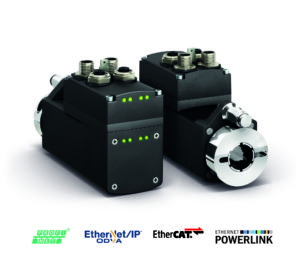
In machines for industrially manufactured bakery products, product changes must be flexible, precise and repeatable. This requires precision with numerous set-up and adjustment options. Siko integrated fieldbus positioning drives into the new “Soft Star CTi” dough dividing and molding machine, which combines the motor, transmission, absolute measuring system, control and power electronics. Industrial producers of pastry and confectionery products must now offer a range of products while still handling fluctuating order quantities.
The WP Kemper Company presented the Soft Star CTi, a high-speed dough dividing and molding machine that automates the switch to new product types at the iba 2015, the leading trade fair for bakery, confectioner and snack producers. The requirements for the installed drives are challenging in several respects: Adjustments of axis positions and contact pressures are necessary during the product changeover in the areas of handling, portioning, and shaping. Automated sub-processes require high repetition accuracy to ensure reliability when changing process variables. Moreover, force transmission necessitates high torques.
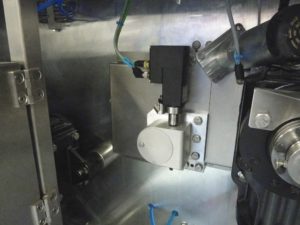
The large fluctuations in the size and weight of the dough pieces also require compact sizes of all drive components to avoid interfering contours. In the search for suitable motors, WP Kemper came across the AG26 actuators from Siko GmbH. They are responsible for the weight adjustment of the raw dough, the height adjustment for product transfers, and the height adjustment of pinch rollers.
The Soft Star CTi is filled with 160 to 300 kilograms of a dough mass. The dough is fed via the main funnel and slides down into the rolling area. There, the quantity defined in the program is separated from the remaining dough. Depending on the processed recipe, dough pieces of 20 to 140 grams are portioned in a measuring drum. The accuracy of the machine is ± 1 gram. The dough pieces are inserted into the bowls of the measuring drum via a feed piston. There, they are pressed together with a defined pressure to ensure the required density of the dough. From the measuring drum, the dough pieces are transported into the rounding device via an internal belt. Through rolling movements, the dough pieces are molded the same way dough is formed by the hands of a baker and, as the final step, is slightly flattened so that the dough balls do not inadvertently roll away during the subsequent processes.
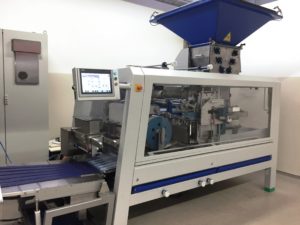
The special feature of the Soft Star CTi is the option to be able to individually parameterize the force transmission. The precise control of the contact pressure flows directly into the quality of the end product. Excessive pressure would “stress” the dough and thus potentially result in undesirable baking results. The correct contact pressure is achieved by the repetition accuracy of the positioning and large torque while minimizing space requirement. These drives can achieve accuracies of half a degree. The resolution is 720 increments per revolution.
The interaction of the actuators within the production unit is synchronized via the machine control. Bus communication takes place via ProfiNET. It can also be realized via Ethernet/IP, Powerlink or EtherCAT. The actuators are integrated into the overall control concept of the machine in the HMI. If a new product is selected, all actuators go to the new position and production can be continued immediately. In addition to the drastic reduction of set-up times, another important advantage is the precise reproducibility of the baking results.
The high degree of process integration makes monitoring the entire process much easier. If for example, the shaft of the drive is blocked, the actuator sends an error signal to the machine control. The HMI acts as the master from which the higher-level process functions are coordinated. However, individual program sequences such as the height adjustment of the rollers are handled independently by the actuators. The system-wide diagnostics makes it possible to detect wear-and-tear at an early stage and to integrate maintenance procedures into the production processes.
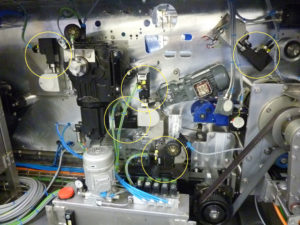
Five SIKO positioning drives ensure automated format changes. Image source: Bernd Ehlermann
Set up is easy as well. The actuator has to simply be mounted on the shaft and the torque support has to be tightened and secured with a clamping ring. No external control panel is required to facilitate the setup operation. The installer controls the axis positions easily with two push-buttons located directly on the actuator. Only a one-time referencing of the axes is required during initial commissioning. The use of an absolute encoder means that no further axis referencing is necessary, even when the shaft is rotated in a voltage-free state.
In order to prevent premature defects of the actuators, control-related protective functions have been integrated: In the case of a mechanically blocked shaft, starting the drive against the mechanical resistance would result in an overload on the motor and possibly even lead to defects. With these drives, the position and the resistance are constantly balanced against one another, detecting lag errors if there are blocked shafts. In this case, the program stops and the fault is immediately reported back to the machine control, which in turn emits an alarm. Thus, the motor’s ability to function is preserved even in the event of a mechanical error. If a spindle becomes more and more difficult to move, the system reports that worn-out components need to be cleaned or replaced.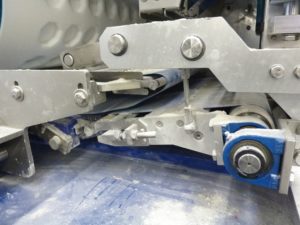
The production area and the drive / electrical area are strictly separated from one another and are located in their own enclosed areas. The power supplies of the control electronics and power electronics are also separate. Thus, the bus communication can be maintained even when the power electronics is turned off. This, in turn, enables an increased degree of safety during maintenance operations in which the control electronics power cannot be switched off.
SIKO
www.siko-global.com


Leave a Reply
You must be logged in to post a comment.